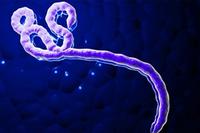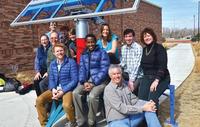-
W.Va. residents still wary about their drinking water
The January 2014 chemical spill in West Virginia, which contaminated the drinking water of 300,000 residents, has changed how residents use public water. Authorities claimed the water was safe for consumption on 13 January, since MCHM levels had dropped below a federal safety threshold of one part per million. Residents remain skeptical, with some collecting rain water, and other relying on clean water distributed by non-profits.
-
-
Lead ammunition should be replaced by steel in shooting sports: experts
Researchers say that Olympic athletes specializing in shooting use one thousand cartridges per week and scatter some 1.3 tons of lead yearly, with harmful effects for surrounding animals and agricultural land. The researchers urge the International Olympic Committee and other sports organizations to replace lead ammunition with steel, which is non-toxic and contains similar technical characteristics.
-
-
Positive results reported from single dose anthrax vaccine studies

Immunovaccine and Pfenex announced positive results from anthrax challenge studies in rabbits using Pfenex’s mutant recombinant Protective Antigen (mrPA) formulated with Immunovaccine’s DepoVax delivery system. Data demonstrates 100 percent protection against a lethal anthrax challenge in animals after vaccination with as little as 0.33 microgram of mutant recombinant Protective Antigen. Dose response observed in the first twenty-eight days following vaccination.
-
-
Bacteriophage “cocktail” eradicates 99 percent of E. coli in meat, spinach
Treating food products with select bacteriophages — viruses which target and kill bacteria — could significantly reduce concentrations of E. coli, a new study shows. An injection of bacteriophages — also known informally as “phages” — nearly eradicated a toxin-producing strain of E. coli in contaminated spinach and ground beef, in some cases decreasing E. coli concentrations by about 99 percent. Interest in using phages as antibacterial treatments has increased with the rise of antibiotic-resistant bacteria.
-
-
New drone-based system improves safety of dealing with nuclear hazards
Hazardous nuclear events have the potential to cause widespread damage to individuals and the environment. Getting close enough to these incidents to accurately assess the problem can be extremely dangerous. Following the incident at the Fukushima power plant in Japan in 2011, for example, helicopter pilots assessing the site were exposed to significant amounts of radiation. Researchers have developed a new system for remote and accurate assessment of dangerous nuclear accident sites.
-
-
Infection control: why doctors over-prescribe antibiotics
The modern antibiotic era began with the discovery of penicillin in 1928, which led to dramatic improvements in our ability to treat common infections. This was probably the most important discovery in the history of modern medicine. And for a long time, antibiotics reigned supreme in the battle against previously deadly bacterium. The dramatic improvements of the twentieth century, however, are now being undone by overuse and misuse of antibiotics. Resistant superbugs and poor use of antibiotics are together leading us toward an “antimicrobial perfect storm” in the next few decades. This may sound apocalyptic but it’s simple epidemiology: increasing resistance combined with decreasing antibiotic options will worsen to the point where we will have no capacity to treat previously highly treatable infections.
-
-
West Virginia chemical spill degrades air, water quality
In the more than two months since the 9 January chemical spill into West Virginia’s Elk River, new findings reveal the nature of the chemicals that were released into the water and then into the air in residents’ houses. The lack of data motivated researchers to take on essential odor-related research that went beyond their National Science Foundation Rapid Response Research grant to better understand the properties of the chemical mixture called crude 4-methylcyclohexane methanol, the major component in the crude mix of the spilled chemicals into the Elk River
-
-
Guinea Ebola outbreak spreading to Liberia, threatening Sierra Leone

The Ebola outbreak in Guinea – the biggest in Africa in seven years — has spread to neighboring Liberia and is now also threatening Sierra Leone. At least eighty-six cases and fifty-nine deaths have been recorded across Guinea, the West African country’s health ministry said Monday. The UN Children’s Fund said the outbreak had spread to the capital, Conakry, although most of the cases so far have been in the country’s south-east provinces. Health officials have not yet been able to determine the subtype of Ebola infecting people in Guinea. Knowing the subtype would give them a better idea of the fatality rate, which, for Ebola, can range from 25 to -90 percent.
-
-
Southeast England residents most at risk of rising deaths from climate change
Warmer summers brought on by climate change will cause more deaths in London and southeast England than the rest of the country, scientists predict. Researchers looked at temperature records and mortality figures for 2001 to 2010 to find out which districts in England and Wales experience the biggest effects from warm temperatures. In the most vulnerable districts, in London and the southeast, the odds of dying from cardiovascular or respiratory causes increased by over 10 percent for every 1C rise in temperature.
-
-
No-refrigeration, spray vaccine to help fight diseases in remote areas
A new kind of single-dose vaccine that comes in a nasal spray and does not require refrigeration could dramatically alter the public health landscape — get more people vaccinated around the world and address the looming threats of emerging and re-emerging diseases.
-
-
HHS proposes rules to govern health-care facilities’ disaster preparedness
The Centers for Medicare and Medicaid Services(CMS), a federal agency within the Department of Health and Human Services, has proposed new requirementsfor health-care facilities intended to ensure these facilities are prepared to care for patients during disasters. The regulations aim to prevent the service disruptions which occurred during Hurricane Sandy and Hurricane Katrina, when an estimated 215 deaths occurred in hospitals and nursing homes in Louisiana.
-
-
Antibiotic-resistant bacteria on the rise among U.S. children
Infections caused by a specific type of antibiotic-resistant bacteria are on the rise in U.S. children, according to a new study. While still rare, the bacteria are increasingly found in children of all ages, especially those 1-5 years old, raising concerns about dwindling treatment options. The researchers found that the prevalence is increasing in a resistant type of bacteria, which produces a key enzyme, extended-spectrum beta-lactamase (ESBL), which thwarts many strong antibiotics, making them ineffective.
-
-
Microbial detection array detects plague in ancient human remains
Scientists who study past pandemics, such as the fourteenth century Black Death, which killed an estimated 30 to 50 percent of the European population from 1347 to 1351, might soon be turning to an innovative biological detection technology for some extra help.
-
-
Killing superbugs dead with “molecular drill bits”
Tuberculosis (TB) is a well-known, treatable disease, but resistant strains are cropping up. The World Health Organization (WHO) estimates that about 170,000 people died from multidrug-resistant TB in 2012. In response to drug-resistant “superbugs” that send millions of people to hospitals around the world, scientists are building tiny “molecular drill bits” which kill bacteria by bursting through their protective cell walls.
-
-
Innovative solar-powered toilet to be unveiled in India next week

Unsafe methods to capture and treat human waste result in serious health problems and death — food and water tainted with pathogens from fecal matter results in the deaths of roughly 700,000 children each year. A revolutionary toilet fueled by the sun is being developed by University of Colorado Boulder researchers to help some of the 2.5 billion people around the world lacking safe and sustainable sanitation. It will be unveiled in India this month.
-
More headlines
The long view
We Ran the C.D.C.: Kennedy Is Endangering Every American’s Health
Nine former leaders of the Centers for Disease Control and Prevention (CDC), who served as directors or acting directors under Republican and Democratic administrations, serving under presidents from Jimmy Carter to Donald Trrump, argue that HHS Secretary Roert F. Kennedy Jr. poses a clear and present danger to the health of Americans. He has placed anti-vaxxers and conspiracy theorists at top HHS positions, and he appears to be guided by a hostility to science and a belief in bizarre, unscientific approaches to public health.
